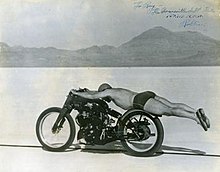HRD Motors Ltd was a British motorcycle manufacturer in the 1920s. It was founded by Howard Raymond Davies. He had worked in motorcycling, and had raced with some success in the mid-twenties, but often not finishing due to unreliability.[1] This inspired him to build a reliable performance motorcycle, using the advertising slogan "Built by a rider". Others also aimed at a similar market, like George Brough of Brough Superior motorcycles.
After the First World War many motorcycle makers assembled their machines from engines and other major components sourced from different manufacturers. Davies' goal was to build a superior motorcycle from the best components available.
Motorcycles were produced from 1924 to 1928, but the undercapitalised company, although having a reputation for performance, struggled to survive, and was ultimately sold to OK-Supreme, who then sold the name and goodwill to Phil Vincent, a motorcycle designer. The name was then incorporated into a new company, The Vincent HRD Company Ltd.
Vincent Motorcycles was a British manufacturer of motorcycles from 1928 to 1955. The business was established by Philip Vincent who bought an existing manufacturing name HRD, initially renaming it as Vincent HRD, producing his own motorcycles as HRD did previously with engines purchased as complete assemblies from other companies. From 1934, two new engines were developed as single cylinder in 500 cc and v-twin 1,000 cc capacities. Production grew from 1936, with the most-famous models being developed from the original designs after the War period in the late 1940s.[7]
The 1948 Vincent Black Shadow was at the time the world's fastest production motorcycle.[8] The name was changed to Vincent Engineers (Stevenage) Ltd. in 1952 after financial losses were experienced when releasing capital to produce a Vincent-engined prototype Indian (Vindian) for the US market during 1949.[7] In 1955 the company discontinued motorcycle production after experiencing further heavy financial losses.
The 1948 Series C Rapide differed from the Series B in having "Girdraulic" front forks – which were girder forks with hydraulic damping.[21] By 1950, the Series C had a 998 cc, 50° V-twin that put out 45 to 55 hp (34 to 41 kW), depending on the state of tune, either Rapide or Black Shadow.[22]
The Black Shadow, capable of 125 mph (201 km/h), and easily recognised by the black coating on the engine and gearbox unit known as Pylumin,[23] and large 150 mph (240 km/h) speedometer, was introduced. The engine produced 54 bhp (40 kW) @ 5700 rpm in Black Shadow trim.[citation needed]
The Black Lightning was a racing version of the Black Shadow; every necessary steel part on it that could be was remade in aluminium, and anything not essential was removed altogether. These changes helped reduce the weight from 458 lb (208 kg) to 380 lb (170 kg).[citation needed] Every bit the racer,[opinion] it had a single racing seat and rear-set footrests.
Rolland "Rollie" Free (18 November 1900 – 11 October 1984) was a motorcycle racer best known for breaking the US motorcycle land speed record in 1948 on the Bonneville Salt Flats, Utah on a Vincent Black Lightning.[24][25] The picture of Free, prone and wearing a bathing suit, has been described as the most famous picture in motorcycling,[26] and Russell Wright won another World Land Speed Record at Swannanoa with a Vincent HRD motorcycle in 1955 at 185.15 mph (297.97 km/h).[27]
The 500 cc Meteor and Comet singles were introduced, along with a 500 cc racer, the Vincent Grey Flash. The Grey Flash racer used Albion gears, for the greater choice of ratios available.[28] The 500 cc bikes used a wet multiplate clutch, while the 998 cc V-twins used a dry, drum-type servo clutch.
Most Vincents had black tanks and frames. In 1949 a White Shadow (a machine to Black Shadow mechanical specification, but with silver engine casings) was available, but only 15 were sold, and the option was dropped in 1952. In 1950 16 Red Comets were shipped to the United States. There were also 31 of the 1948 Grey Flash built.[29][better source needed]
During the Korean War nickel chrome steel was officially regulated, meaning the correct materials for some components (e.g. gears) were not available.[30] Some motorcycles built during this period had black rims.
From 1950, HRD was dropped from the name, and the logo now simply read The Vincent.[

No comments:
Post a Comment